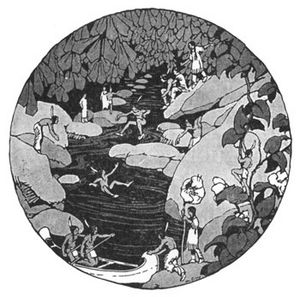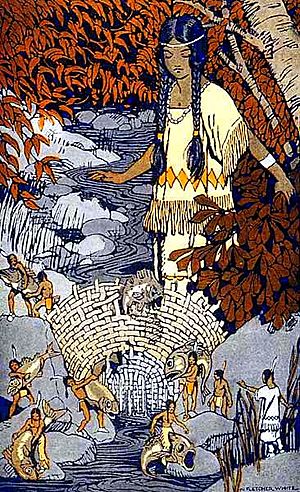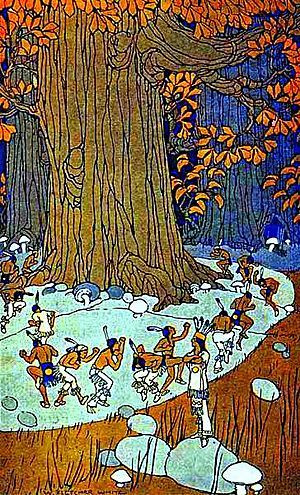Little people (mythology) facts for kids
Little people are a fascinating part of stories and beliefs from many cultures around the world. These tales, known as folklore, have been shared for a very long time. You can find stories about little people in places like Ireland, Greece, the Philippines, the Hawaiian Islands, New Zealand, Flores Island in Indonesia, and among Native American communities.
Contents
Native American Folklore About Little People
Many Native peoples in North America have old legends about a special group of "little people." These beings are said to live in the woods, often near sandy hills or rocks by large bodies of water, like the Great Lakes. Stories sometimes describe them as "hairy-faced dwarfs." Ancient rock carvings, called petroglyphs, even show them with horns on their heads, traveling in small groups in canoes.
Native legends often say that these little people love to play tricks. They might sing beautiful songs, but then hide when someone tries to find the music. It's also often told that the little people care deeply for children. They might even take children away from parents who are not kind, or help kids who are lost and alone in the woods.
Other stories suggest that if an adult human sees the little people, they will ask them to keep their secret. If you keep your promise, they might reward you and your family by helping you when you need it most. The way the little people act, and whether they are seen as good or bad, can change from one tribe's story to another.
One common belief is that the little people create distractions to cause mischief. Some tribes even believed they were gods. One North American Native tribe thought they lived in nearby caves. People were often afraid to go into these caves, so they wouldn't disturb the little people.
There are also stories about finding tiny human-like remains in places like Montana and Wyoming. These tales often describe them as "perfectly formed" and dwarf-sized. However, scientists who study old human remains, called archeologists, explain that these findings are often misinterpretations. For example, some discoveries were actually the remains of infants with certain birth differences, which people mistakenly thought were tiny adults.
The famous explorers Lewis and Clark wrote in their journals about Native Americans near Spirit Mound in South Dakota. The local tribes believed little people lived in the mound. Clark noted that the Native Americans were too scared to go near it, seeing these tiny beings as dangerous. Even though Lewis and Clark's group visited the mound, they didn't see any unusual creatures themselves.
In the 1830s, a graveyard was found in Coshocton County, Ohio. People thought it held skeletons of a pygmy race. But actually, the graves were about 3 feet (0.91 m) long and contained bones that had been carefully arranged or folded, not tiny full skeletons.
Native American Little People Names
Different Native American tribes have their own names and stories for these little people:
- Alux - Maya
- Canotila - Lakota
- Chaneque - Aztec
- Geow-lud-mo-sis-eg - Maliseet
- Jogah - Iroquois
- Mannegishi - Cree
- Memegwesi/Memegawensi/Memengweshii/Pa'iins - Anishinaabe
- Nimerigar - Shoshone
- Nirumbee or Awwakkulé - Crow
- Popo-li or Kowi Anukasha - Choctaw
- Pukwudgie - Wampanoag
- Yehasuri - Catawba
- Yunwi Tsunsdi - Cherokee
The Native American little people are sometimes said to live in the Pryor Mountains in Montana and Wyoming. This area is known for its "fairy rings" and strange events. Some members of the Crow tribe consider the little people to be important ancestors. They often leave offerings when they enter the area as a sign of respect.
Memegwaans of the Ojibwe
Ojibwe myths tell of a creature called the Memegwaans (or Memegwaanswag for plural). This creature seems different from the more common Memegwesi little people. According to Basil H. Johnston, a Memegwaans is a little person without a clear shape. They are very scared of adult humans.
However, they have a soft spot for children. They often appear as a child to any young person who is sad, hurt, scared, or lonely. They might protect the child or keep them company until help arrives. If an adult sees a Memegwaans, it will often cower, scream, and cry before vanishing very quickly. These beings were also known as protectors of copper mines and were almost prayed to as guardians of lost children. This is more specific than the Memegwesi, which is often just described as a short, hairy man.
Types of Little People in Mythology
Many different cultures have their own versions of little people in their myths and legends. Here are some examples:
- Abatwa
- Aziza (African mythology)
- Brownies
- Christmas Elves
- Clurichauns
- Di sma undar jordi
- Dokkaebi
- Domovoi
- Duende
- Dwarves
- Ebu Gogo (from Flores)
- Egbere
- Eloko
- Elves
- Far Darrig
- Gnomes
- Goblins
- Gremlins
- Grogoch
- Heinzelmännchen
- Hob
- Hobgoblin
- Imp
- Iratxo
- Jenglot
- Kabouter
- Kaichigo
- Kallikantzaros
- Kandap - Tayap
- Karzełek
- Knocker
- Kijimuna
- Kobolds
- Korpokkur
- Krasnoludek
- Laminak
- Leprechauns
- Lutins
- Madebele - Senufo mythology
- Menehune - Hawaiian mythology
- Muki
- Niß Puk
- Nimerigar
- Nittaewo (Sri Lanka)
- Nuno sa Punso
- Patupaiarehe - New Zealand Maori mythology
- Pixies
- Polevik - Slavic mythology
- Pombero - Guarani mythology
- Pygmies (in Greek mythology)
- Qutrub
- Redcap
- Siyawesi - Benin
- Sprites
- Ta'ai, or 小黑人 - in the mythology of the Saisiyat people of Taiwan
- Taotao Mona
- Tikoloshe
- Tomte / Tonttu / Nisse - Scandinavian Folklore
- Trauco - Chilote mythology
- Trows - Orkney and Shetland folklore
- Tylwyth Teg
- Vazimba
- Woodarjee - Noongar mythology
- Yumboes
- Zlydzens
Little People in Literature
Little people also appear in many popular books and stories:
- The Borrowers by Mary Norton
- The Littles by John Peterson
- The Wee Free Men by Terry Pratchett
- The Nome Trilogy by Terry Pratchett
- The Spiderwick Chronicles by Holly Black and Tony DiTerlizzi
- 1q84 by Haruki Murakami
- Rumpelstiltskin




